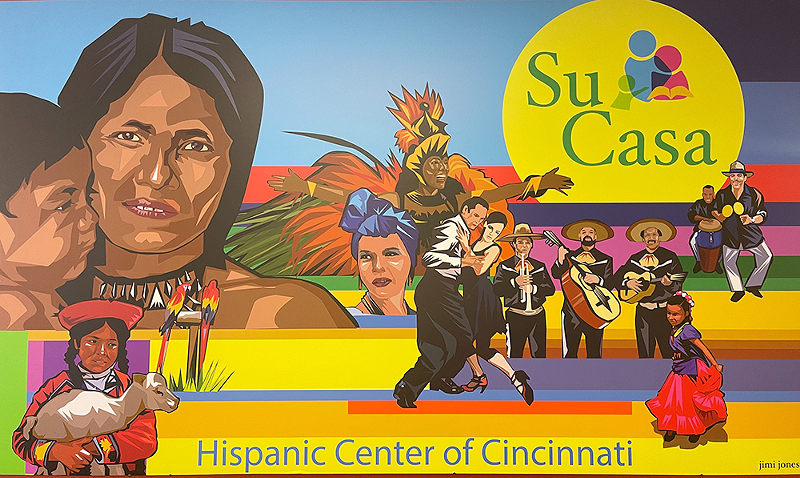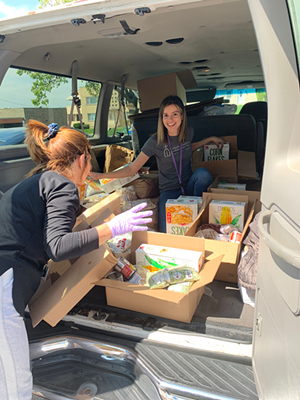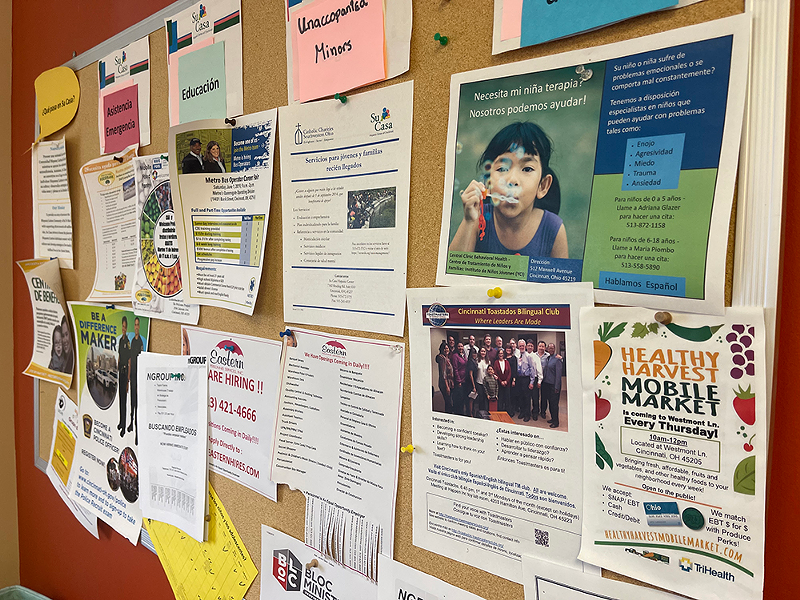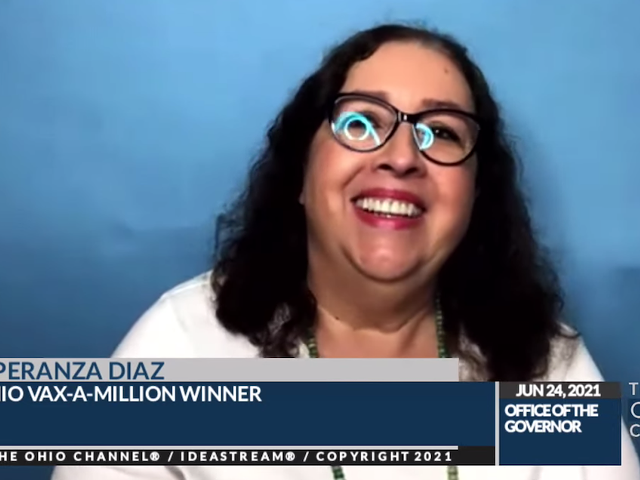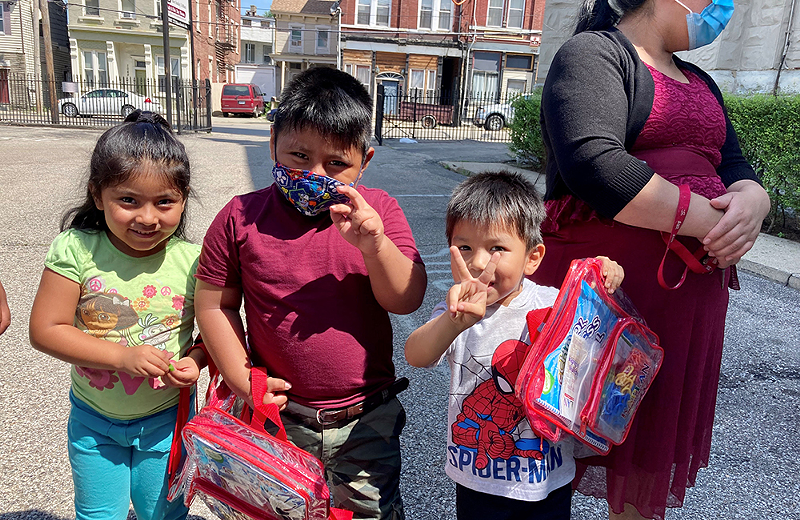
Hispanic people are the fastest-growing immigrant group in Ohio, with a 63.4% increase in population since the year 2000, according to the Greater Cincinnati Latino Coalition. And since the outbreak of COVID-19 in 2020, this same group has also faced some of the highest coronavirus infection rates in the country.
The Centers for Disease Control and Prevention (CDC) says that Hispanics in America are twice as likely as white Americans to contract COVID-19 and 2.3 times as likely to die from it due to “underlying conditions that affect health, including socioeconomic status, access to health care and exposure to the virus related to occupation.”
To help this vulnerable population during the pandemic, three Greater Cincinnati organizations — Su Casa Hispanic Center, Santa Maria Community Services and the Community Action Agency — sprang into action, offering COVID-focused assistance and essential resources in addition to their existing services.
“Su Casa” roughly translates to “your home,” which is what Su Casa Hispanic Center strives to be for the Cincinnati Hispanic community: a home base, a safe space and, most importantly, a vital resource.
“When (immigrants) are new to the community, they come to Su Casa because they find a place that is friendly to them; a refuge in the city,” says Director Giovanna Alvarez. “They come here first and then we help them navigate all of these new environments.”
Run by Catholic Charities of Southwestern Ohio since 1997, Su Casa offers dozens of resources ranging from social to educational to health services. Since the rise of COVID-19, the organization — like SMCS and CAA — has adjusted to focus on needs rooted in the pandemic, such as putting together and delivering household care packages; contributing direct financial assistance toward rent and utilities; offering notary and legal services; conducting health screenings; hosting tutoring and English classes; providing laptops to children for remote learning; and distributing Spanish-language information packets about COVID-19 and the stay-at-home orders.
“Many (people we serve) don’t speak English as a first language. They didn’t understand what was going on, or why their children weren’t going to school,” Alvarez says. “So we were able to explain COVID-19, the importance of social distancing and wearing a mask.”
According to the last U.S. Census, Hispanics make up 3%-4% of the population in the Cincinnati area. Although this number is low, Hispanics and Latinos that were tested for COVID-19 have had the highest positivity rate for the virus, says Alvarez — likely for the “underlying conditions” cited by the CDC.
During a panel discussion on racism and public health at the University of Cincinnati in March, professor Ligia Gomez noted that many immigrant families live in multigenerational homes, and if one family member gets infected with COVID-19, the number of people exposed is much higher than in a ‘traditional’ household structure.
And a 2016 study published in the Journal of Health Care for the Poor and Underserved showed that the majority of the Hispanic immigrant population (56%) relies on community health clinics as opposed to having a primary care doctor or seeking care from a larger health system.
The study noted that “many Latino immigrants interact with the health care system and other institutions as infrequently as possible because they are afraid of being asked about their immigration status.”
Lack of documentation also poses a challenge to accessing medical insurance and even reliable transportation because you need a social security number to register a vehicle or get a driver’s license.
And, because of their status, many immigrant families were not able to collect stimulus checks or unemployment benefits, which made working throughout the pandemic — and risking COVID-19 exposure — a necessity.
“Because who are the essential workers?” Alvarez asks. “Those are the people of minorities. Those are the people who could not afford to be working at home.”
Alvarez says many of Su Casa’s clients come to the U.S. to escape extreme poverty and extreme violence.
“They are sometimes fleeing for their lives,” she says.
The often-traumatic personal histories of clients can make it difficult for them to trust outside help, even if it comes in the form of a nonprofit built to directly assist these communities.
Price Hill’s SMCS has been serving Cincinnati immigrant communities since 1897, when it was founded by “two nuns and $5,” according to Luz Elena Schemmel, director of outreach and wellness services for SMCS.
Over the years, the agency has served the city’s various immigrant waves, starting with Greek, Italian and German people, followed by immigrants from Appalachia and then, in the past 20 years, those from Central and South America and West Africa.
At the beginning of the pandemic in 2020, SMCS partnered with the United Way of Greater Cincinnati to secure and distribute personal protective equipment (PPE) and offer hand sanitizer made by local distilleries to families who could not obtain or afford such items.
Fast-forward to 2021 and SMCS has turned its focus to offering COVID-19 vaccines to everyone they serve, hosting a health fair with free testing for COVID-19 antibodies and antigens, along with no-cost vaccinations.
Schemmel notes that there is difficulty in convincing people to receive a vaccine due to misinformation and lack of Spanish-language information on the topic. To counter this, SMCS visited Hispanic-owned businesses directly to spread accurate information, encouraging people to receive vaccinations.
Distributing Spanish-language information about the virus and vaccines has also become a priority for the CAA.
Founded in 1964, the CAA has primarily worked with low-income Black families in Hamilton County, but hired its immigrant liaison Mayra Jackson in 2019 to help serve other low-income groups in the area, including those from Central and South America. In addition to hosting a Head Start program for children and Camp Washington food pantry, the CAA recently held a town hall in Spanish for the community.
“For the vaccination, the amount of information you find available in Spanish is almost zero,” Jackson says. “When you call to make an appointment for your vaccine, nobody speaks Spanish. There are no interpreters available. So how can we really push the community to go get vaccinated when it’s so difficult for them to even schedule an appointment?”
She says it is crucial that families understand that it is not necessary to have health insurance to receive a vaccine, nor is it necessary to have proof of documentation.
“Historically, undocumented immigrants, unlike everybody else, are not eligible for anything,” Jackson says. “They don’t have access to medical care, they don’t have access to food stamps, cash assistance, housing assistance, absolutely nothing.”
While it is undeniable that the loss the world has faced from COVID-19 outweighs the gains, there are silver linings from the work done by these organizations.
Alvarez believes that the pandemic’s forced transition to virtual learning may have positive effects in the long term.
“Our tutoring program was in partnership with two schools, but now because they have this virtual access, we have children from more than 10 different schools participating,” she says. “We’ve seen a lot of things come to light about the disparities and the digital divide, but (as more children have access to technology), it is going to be more of an equalizer in the future; the long-term disparities are probably going to lessen a bit.”
Schemmel agrees that the way COVID pushed the world to go online has allowed families to gain access to computers and the internet through programs that may not have otherwise been implemented.
Jackson notes that the pandemic forced many people who previously would not have asked for help to turn to organizations for assistance because “they had no other choice.” She hopes that these people will continue to utilize and benefit from these services even after a return to “normal.”
And whatever the timeline for that return, Alvarez says, “We continue to serve, despite it all.”
To obtain information and resources from Su Casa Hispanic Center, visit ccswoh.org; from Santa Maria Community Services, visit santamaria-cincy.org; and from the Community Action Agency, visit cincy-caa.org.

